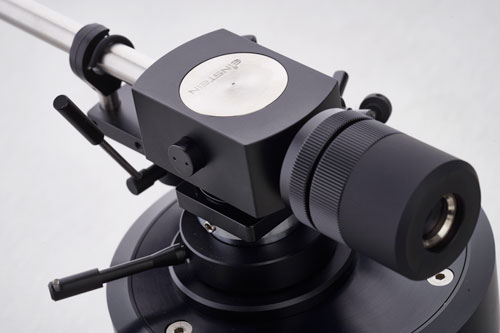
Unlike a solid-state amplifier, the output power drops when a lower impedance speaker is connected. Therefore, it's best that the speaker impedance should be eight ohms, or even more. Speakers with any drops down to an ohm in the impedance curve or similar bodgeries should be left to other playgrounds. What is also interesting is that the amplifier runs up to a bandwidth of three (!) Megahertz, which then again requires a Boucherot filter in the output. This is to prevent greater nonsense here. The changes in the new Silver Bullet now do not refer to the circuitry, but concern more detailed solutions. I consider this to be quite a positive sign, because if a circuit is properly designed, then there is no "Mark II" version showing up half a year later. In the case of the Einstein monos, the stabilization of the power supplies was improved as well as the housing mechanically stabilized. After all, there has to be a reason for the 30 kilos of weight."

So far, colleague Jürgen Saile. Let me just point out that the Silver Bullets have been lifted to a higher level by Harmonix BeauTone Million Maestro cable, and that in a double sense: physically and sonically. The Thunder cable directly connects the mid-range driver of the semi-active speaker system The Pure to the power tubes of the mono amps. The Fostex mid-woofer unit with a diameter of 15 centimeters works completely without crossover and is supported in the high frequencies by a Fostex ring radiator with aluminum horn. In the signal path a single capacitor determines the starting point of its operating frequency. In order to adjust the high frequency range to the listening room or the owner's taste respectively, Einstein offers the choice between three capacitors with different values to be selected by means of a rotary switch, of which, as already mentioned, only one capacitor is located in the signal path. The puristic concept of the mid-high module is countered by an opulent bass unit: An IcePower amplifier with an output power of 700 watts serves to prompt a 26-centimeter woofer. A purely analogue crossover allows the frequency and the level to be adapted to the mid-woofer via a rotary control. The high power is required to allow for a sufficient cone travel of the woofer, which has to work on a very small volume. The small volume of the cabinet is intended to provide a colourful and fast bass and prevent the so-called "one note bass." As Volker Bohlmeier explains, the closed cabinet principle also allows the subwoofer to be precisely controlled below its resonance frequency, which makes the placement of The Pure in the listening room very unproblematic. In conjunction with the active bass control, the frequency response of The Pure goes down to 20Hz.
-
Einstein The Tonearm 12 Zoll
Einsteins The Tonearm gibt es ganz klassisch in den Längen von neun und zwölf Zoll. Die kurze Version hat seit über einem Jahr fast ununterbrochen die nahe Position auf meinem LaGrange behauptet und muss sich nun am Zwölf-Zöller messen: Bedeutet mehr Länge auch mehr Wohlklang? Falls Sie sich an die Vorstellung von The Tonearm in Hifistatement nicht so recht erinnern können, wird das wahrscheinlich daran liegen, dass er seine Test-Premiere im ersten Teil des Erfahrungsberichts…15.06.2018 -
Einstein Audio Components – The System – Part 1
Anyone who has ever looked into the hi-fi world in a little bit more intensive way knows that the arbitrary combination of well-reputed audio components does not necessarily lead to a guaranteed musical enjoyment. In the field of high-end audio, only very few manufacturers offer complete solutions—mainly those featuring a digital source. To my knowledge, Einstein is the only laudable analogue exception. However, I do not want to anticipate: The analogue turntable, of which prototypes…31.05.2017 -
Einstein Audio Components Komplettanlage – Teil 2
Bei der Beschäftigung mit der Komplettanlage von Einstein mit analoger Quelle waren wir im ersten Teil über Tonabnehmer, Tonarm und Phonostufe bis zur Vorstufe gekommen. Nun folgen die Endstufen und das teilaktive Lautsprechersystem The Pure – und natürlich der Klang. Natürlich geht es per XLR-Kabel von der vollsymmetrisch aufgebauten Vorstufe The Preamp zu den OTL-Endstufen The Silver Bullet, in deren Schaltung Symmetrie ebenfalls eine nicht zu vernachlässigende Rolle spielt. Aber Details dazu sowie zum Konzept…08.05.2017 -
Einstein Audio Components Komplettanlage – Teil 1
Wer sich auch nur ein wenig intensiver mit Hifi beschäftigt hat, weiß, dass die willkürliche Kombination auch von bestens beleumundeten Komponenten keinen Musikgenuss garantiert. Im High-End-Bereich bieten nur sehr wenige Hersteller Komplettlösungen an – und wenn, dann solche mit digitaler Quelle. So weit ich weiß, ist Einstein die einzige rühmliche analoge Ausnahme. Allerdings greife ich mit dieser Aussage ein wenig vor: Das Analog-Laufwerk, von dem auf Messen schon seit Jahren Prototypen zu sehen waren, lässt…05.05.2017 -
AudioMachina V8
Daran, dass unscheinbare Teilchen einen beachtlichen klanglichen Effekt haben können, sind wir dank Jitterbug, iDefender3.0 und auch dank Audio-Exklusivs Silenthead längst gewohnt. Meist korreliert der Preis der Helferlein mit ihrer Größe. Aber AudioMachina bewegte sich noch nie auf ausgetretenen Pfaden. Das ist beim V8 nicht anders. Vor etwas mehr als anderthalb Jahren hatte ich das Vergnügen, erst die großartigen, teilaktiven AudioMachina Lautsprechersysteme Maestro GSE zu testen und etwas später während der hifideluxe ihren Entwickler, Dr.…10.01.2017 -
EINSTEIN - The PowerAmp
Ein Verstärker wandelt ein schwaches elektrisches Signal am Eingang in ein stärkeres elektrisches Signal am Ausgang um. Bei einem idealen Verstärker entspricht hierbei das Ausgangssignal exakt dem Eingangssignal. Es dürfen keine Störungen hinzugefügt und es darf auch nichts weggelassen werden; also das berühmte Stückchen Draht mit Verstärkung. Die wesentlichen Qualitätskriterien für einen Endverstärker aus messtechnischer Sicht sind möglichst geringe Verzerrungen, eine hohe Bandbreite, ein möglichst geringer Innenwiderstand, möglichst geringes Rauschen und eine hohe Arbeitspunktstabilität der…21.03.2016
© 2024 | HIFISTATEMENT | netmagazine | Alle Rechte vorbehalten | Impressum | Datenschutz



















 |
|



























































































